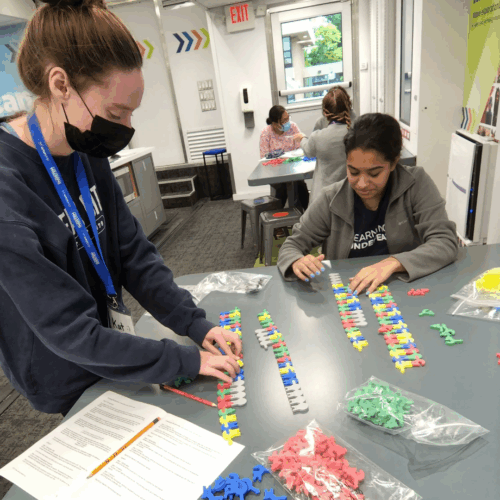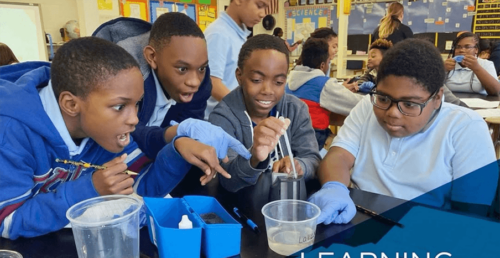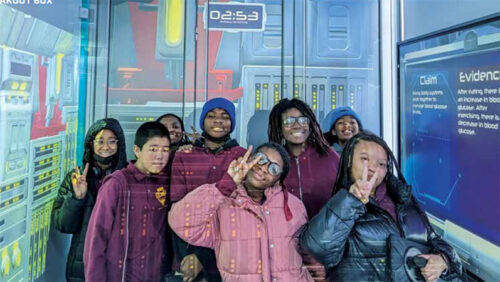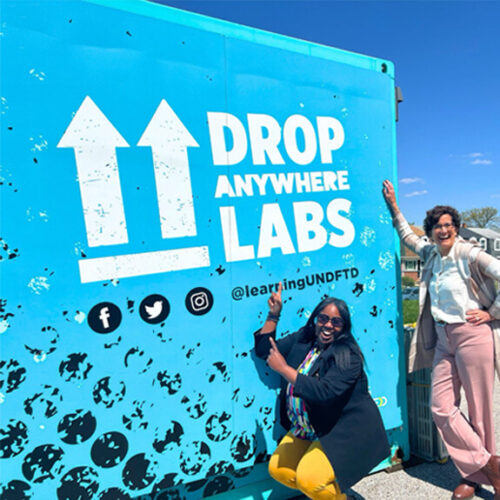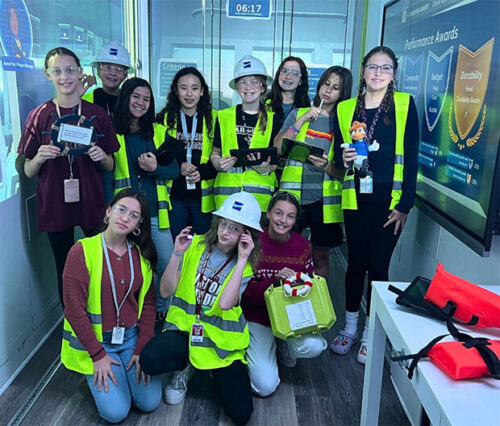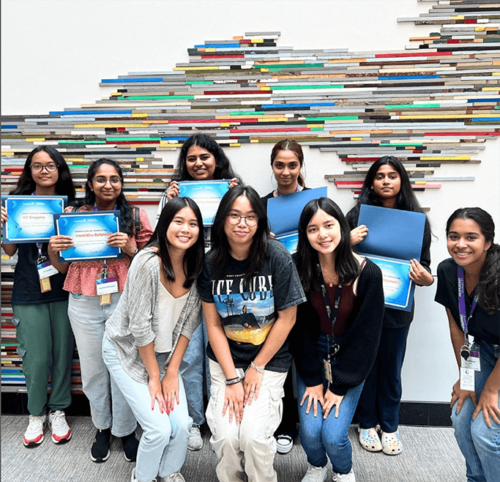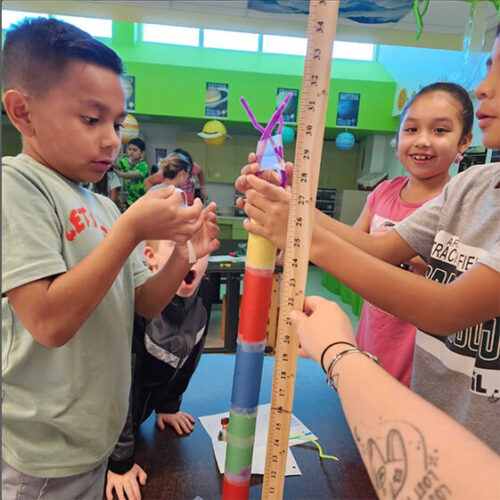Learning Undefeated’s Talent Accelerator Pathway is designed to close the career awareness gap for students in marginalized communities, foster the talent pipeline, and prepare high school students for careers in high-demand STEM fields. The program’s design and execution are the result of more than 20 years of direct service to schools and students and are supported by numerous research studies.
Program: Talent Accelerator Pathway
Audience: High school and college students with an emphasis on BIPOC women, ages 14-22
Program Summary & Outcomes
Learning Undefeated’s Talent Accelerator Pathway connects high school and college students with meaningful STEM experiences and links them with positive industry-specific experiences. Talent Accelerator Pathway outcomes include increased student achievement, content knowledge gains, improved attitudes and confidence levels towards STEM topics, awareness of STEM careers, and interest in pursuing a STEM career.
Research-Informed Program Design
Learning Undefeated prioritizes research-based student engagement as the primary goal in expanding access to high-quality, immersive STEM education. Ensuring that students and educators are engaged in a variety of interconnected STEM experiences is essential for building STEM talent pools (1). But persistent inequities in access, participation, and success in STEM subjects that exist along racial, socioeconomic, gender, and geographic lines threaten the nation’s ability to close education and poverty gaps, meet the demands of a technology-driven economy, ensure national security, and maintain preeminence in scientific research and technological innovation (2).
Learning Undefeated uses a blend of immersive, informal learning environments to capture and keep students’ attention while building confidence and skills. Informal learning environments increase students’ interest in STEM and increase the chances a student will pursue a STEM career (3). Students who participate in immersive STEM programs have increased interest in STEM majors and career fields, increased self-efficacy and confidence in STEM, and improved content learning (4). Similarly, students who participate in STEM-centered after-school programs demonstrate increases in STEM interest, STEM identity, STEM career knowledge, and 21st-century STEM skills (5).
But we’re about more than just a tricked out vehicle – we’ll hunt down the coolest science events & happenings, report on new research and send internship opportunities your way.
Fostering Belonging for Students from Marginalized Groups
Learning Undefeated’s mission to drive race and gender equity in STEM includes broadening participation for underrepresented students within STEM fields through a variety of levers. A pivotal component of success in STEM and ultimately influence of career choice is whether students feel a sense of “belonging” or acceptance and fit in STEM (6). Gender and ethnicity can impact feelings of acceptance, with students from underrepresented groups reporting more uncertainty about whether they belong in their academic fields than students from well-represented demographic groups (7).
Feelings of belonging and interest in STEM contribute to a student’s STEM identity or the degree to which someone perceives STEM as a key component of their sense of self (8). Conversely, lack of identification is a major barrier to retention and success and threatens underrepresented groups from participating more fully in fields dominated by other genders or ethnic groups (9). Mentorship is an important factor for the retention of underrepresented students in STEM, allowing underrepresented students to see themselves within STEM and create their own pathways toward a STEM career (10). Exposure to STEM career professionals is especially important to women; contact with female experts in STEM has enhanced women’s self-concept in STEM, attitudes toward STEM, and motivation to pursue STEM careers (11).
Increasing engagement in STEM among students from underrepresented groups can positively affect the future STEM workforce and talent pool (12). Increasing representation of women and people of color in STEM fields can help increase diversity, creativity, and innovation in STEM (13). Analysis of more than one million patent applications, for example, suggests that the number of inventions created in the US could quadruple if children from low-income communities had the same access to innovation during childhood as their wealthier peers (14).
Program Results
When students are exposed to real-world, relevant STEM experiences and connected to the work of STEM professionals, they more likely to have positive attitudes toward STEM or aspirations for STEM careers (15). Strong access to and preparation in high school STEM is highly correlated with retention, persistence, and success among college students who are pursuing a STEM degree, especially for students of color (16). Culturally relevant STEM activities and enrichment can also help students navigate the STEM pipeline and close the achievement gap (17).
To date, Talent Accelerator Pathway participant survey data has indicated:
- 400% increase in student interest towards biotechnology careers
- 66% of students gained new knowledge and skills in STEM and 54% of students said the mobile lab experience made them think creatively about a STEM project.
- 58% of students felt prepared for more challenging STEM activities, and 57% wanted to learn more about STEM topics.
- 80% of students learned that “I can use STEM to do something interesting.”
References
(1) Committee on STEM Education [CoSTEM] (2018). Charting a course for success: America’s strategy for STEM education. National Science & Technology Council.
(2) U.S. Department of Education. (2016). STEM 2026: A vision for innovation in STEM education. https://www.air.org/system/files/downloads/report/STEM-2026-Vision-for-Innovation-September- 2016.pdf
(3) Kitchen JA, Sonnert G, Sadler PM. The impact of college-and university-run high school summer programs on students’ end of high school STEM career aspirations. Science Education. 2018;102(3):529–547. doi: 10.1002/sce.21332.
(4) Saw, G.K., Swagerty, B., Brewington, S., Chang, C-N., & Culbertson, R. (2019). Out of school time STEM program: Students’ attitudes toward and career interests in mathematics and science. International Journal of Evaluation and Research in Education, 8(2), 356-362.
(5) Allen, P., Noam, G. Little, T., Fukuda, E., Chang, R., Gorrall, B., & Waggenspack, L. (2016). Afterschool & STEM: System building evaluation 2016. The PEAR Institute, Harvard Medical School and McLean Hospital and the Institute for Measurement, Methodology, Analysis & Policy, Texas Tech University.
(6) Ito, T. A., & McPherson, E. (2018). Factors influencing high school students’ interest in pSTEM. Frontiers in Psychology, 9, 1535. https://doi.org/10.3389/fpsyg.2018.01535.
(7) Zaniewski, A. M., & Reinholz, D. (2016). Increasing STEM success: a near-peer mentoring program in the physical sciences. International Journal of STEM Education, 3, 14. https://doi.org/10.1186/s40594-016-0043-2.
(8) Kim, A. Y., & Sinatra, G. M. (2018). Science identity development: an interactionist approach. International Journal of STEM Education, 5, 51. https://doi.org/10.1186/s40594-018-0149-9.
(9) Sinclair, S, Carlsson, R, Björklund, F (2014). The role of friends in career compromise: same-gender friendship intensifies gender differences in educational choice. Journal of Vocational Behavior, 84(2), 109–118.
(10) Cheryan, S., Ziegler, S. A., Montoya, A. K., & Jiang, L. (2017). Why are some STEM fields more gender balanced than others? Psychological Bulletin, 143(1), 1-35. https://doi.org/10.1037/bul0000052
(11) Stout, J. G., Dasgupta, N., Hunsinger, M., & McManus, M. A. (2011). STEMing the tide: Using ingroup experts to inoculate women’s self-concept in science, technology, engineering, and mathematics (STEM). Journal of Personality and Social Psychology, 100(2), 255.
(12) U.S. Department of Education. (2016). STEM 2026: A vision for innovation in STEM education. https://www.air.org/system/files/downloads/report/STEM-2026-Vision-for-Innovation-September- 2016.pdf
(13) Kricorian, K., Seu, M., Lopez, D., Ureta, E., & Equils, O. (2020). Factors influencing participation of underrepresented students in STEM fields: Matched mentors and mindsets. International Journal of STEM Education, 7(1), 16. https://doi.org/10.1186/s40594-020-00219-2
(14) Bell, A., Chetty, R., Jaravel, X., Petkova, N, and Van Reenen,J. (2019). “Who Becomes an Inventor in America? The Importance of Exposure to Innovation*,” The Quarterly Journal of Economics, vol 134(2), pages 647-713.
(15) Fuesting, M. A., & Diekman, A. B. (2017). Not by success alone: Role models provide pathways to communal opportunities in STEM. Personality and Social Psychology Bulletin, 43(2), 163-176.
(16) Palmer, R. T., Maramba, D. C., & Dancy, T. E. (2011). A qualitative investigation of factors promoting the retention and persistence of students of color in STEM. Journal of Negro Education, 80(4). https://works.bepress.com/robert_palmer/28/
(17) Young, K. L. (2007, November). Recruiting future engineers through effective guest speaking in elementary school classrooms. Proceedings of the IEEE Meeting the Growing Demand for Engineers and Their Educators 2010-2020 International Summit, Munich, Germany, 2007, pp. 1-14, doi: 10.1109/MGDETE.2007.4760352
